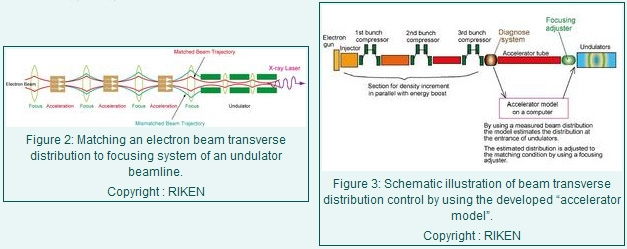Home > Press > Next-generation light source gets boost from powerful new analysis technique
 |
Abstract:
A new analysis technique for the design and optimization of beam optics has successfully been used to model the group behavior of electron beams over a linear accelerator, paving the way for its use at linear accelerator based light source facilities around the world.
Next-generation light source gets boost from powerful new analysis technique
Tokyo | Posted on November 5th, 2010The technique contributes to improved operation of the X-ray Free-Electron Laser (XFEL) under construction at the RIKEN SPring-8 synchrotron radiation facility, whose intense beams will open a unique window onto the minuscule structure of molecules and the rapid reaction of chemical species.
Despite its key importance to all fields of science, the world of atoms and molecules exists beyond the reach of traditional observation techniques, holding back progress in research on everything from molecular biology to nanotechnology.
The new XFEL at RIKEN, Japan's flagship research institute, will shed first-ever light on this hidden world, delivering radiation one billion times brighter and with pulses one thousand times shorter than existing X-ray sources such as SPring-8. The XFEL facility will be only the second laser of its kind in the world when it opens in 2011.
Obtaining a stable XFEL beam, however, is not an easy task. To do so, the transverse distribution of electrons ejected from the XFEL's linear accelerator must be carefully calibrated each time conditions change to match the configuration of magnets (undulators) where X-ray laser radiation is emitted (Fig. 2). In experiments with a small test accelerator, researchers performed this calibration by directly measuring the laser intensity, but the full-sized XFEL is too complicated for this approach to work.
The new technique, developed at RIKEN and the Japan Synchrotron Radiation Research Institute (JASRI), solves this problem by rapidly and precisely computing the effect of changes in optics using information on electron beam distributions after full bunch compression (Fig. 3). By doing so, the technique plays a key role in ensuring the successful operation of the XFEL, whose intense beams promise to herald a new era of scientific exploration and discovery.
Journal information
Toru Hara, Kazuaki Togawa and Hitoshi Tanaka. Transverse envelope analysis for accelerating relativistic electron beams in a linear accelerator as a photon source. Nuclear Instruments and Methods in Physics Research Section A, 17 September 2010. DOI: 10.1016/j.nima.2010.09.035
####
For more information, please click here
Contacts:
Dr. Hitoshi Tanaka
Beam Commissioning Team
XFEL Project Head Office
Tel/Fax: +81-(0)791-58-2862
Ms. Tomoko Ikawa (PI officer)
Global Relations Office
RIKEN
Tel: +81-(0)48-462-1225
Fax: +81-(0)48-463-3687
Copyright © RIKEN
If you have a comment, please Contact us.Issuers of news releases, not 7th Wave, Inc. or Nanotechnology Now, are solely responsible for the accuracy of the content.
| Related News Press |
News and information
![]() Researchers develop molecular qubits that communicate at telecom frequencies October 3rd, 2025
Researchers develop molecular qubits that communicate at telecom frequencies October 3rd, 2025
![]() Next-generation quantum communication October 3rd, 2025
Next-generation quantum communication October 3rd, 2025
![]() "Nanoreactor" cage uses visible light for catalytic and ultra-selective cross-cycloadditions October 3rd, 2025
"Nanoreactor" cage uses visible light for catalytic and ultra-selective cross-cycloadditions October 3rd, 2025
![]() Researchers tackle the memory bottleneck stalling quantum computing October 3rd, 2025
Researchers tackle the memory bottleneck stalling quantum computing October 3rd, 2025
Laboratories
![]() Researchers develop molecular qubits that communicate at telecom frequencies October 3rd, 2025
Researchers develop molecular qubits that communicate at telecom frequencies October 3rd, 2025
Chemistry
![]() "Nanoreactor" cage uses visible light for catalytic and ultra-selective cross-cycloadditions October 3rd, 2025
"Nanoreactor" cage uses visible light for catalytic and ultra-selective cross-cycloadditions October 3rd, 2025
![]() Cambridge chemists discover simple way to build bigger molecules – one carbon at a time June 6th, 2025
Cambridge chemists discover simple way to build bigger molecules – one carbon at a time June 6th, 2025
Possible Futures
![]() Spinel-type sulfide semiconductors to operate the next-generation LEDs and solar cells For solar-cell absorbers and green-LED source October 3rd, 2025
Spinel-type sulfide semiconductors to operate the next-generation LEDs and solar cells For solar-cell absorbers and green-LED source October 3rd, 2025
Announcements
![]() Rice membrane extracts lithium from brines with greater speed, less waste October 3rd, 2025
Rice membrane extracts lithium from brines with greater speed, less waste October 3rd, 2025
![]() Researchers develop molecular qubits that communicate at telecom frequencies October 3rd, 2025
Researchers develop molecular qubits that communicate at telecom frequencies October 3rd, 2025
![]() Next-generation quantum communication October 3rd, 2025
Next-generation quantum communication October 3rd, 2025
![]() "Nanoreactor" cage uses visible light for catalytic and ultra-selective cross-cycloadditions October 3rd, 2025
"Nanoreactor" cage uses visible light for catalytic and ultra-selective cross-cycloadditions October 3rd, 2025
|
|
||
|
|
||
| The latest news from around the world, FREE | ||
|
|
||
|
|
||
| Premium Products | ||
|
|
||
|
Only the news you want to read!
Learn More |
||
|
|
||
|
Full-service, expert consulting
Learn More |
||
|
|
||








